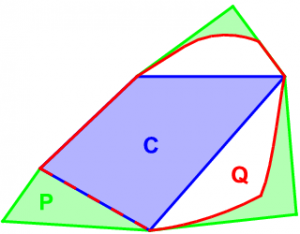Cite this problem as Problem 26.
Problem
Below are two connected problems, both asking for a better description of the possible correlation polytopes.
Background
The setting for this problem is the same as for [[All the Bell Inequalities|Problem 1]]: We consider correlations between ![]() parties, each of which can perform
parties, each of which can perform ![]() different measurements yielding one of
different measurements yielding one of ![]() possible outcomes each. We can reduce the number of dimensions by considering only those correlation data satisfying the no-signalling constraint, i.e., the choice of a measuring device by one party
possible outcomes each. We can reduce the number of dimensions by considering only those correlation data satisfying the no-signalling constraint, i.e., the choice of a measuring device by one party ![]() never changes the (joint) probabilities seen by all the other parties, unless results are selected with respect to the outcomes of
never changes the (joint) probabilities seen by all the other parties, unless results are selected with respect to the outcomes of ![]() . Only obeying no-signalling and positivity constraints, we get the no-signalling polytope
. Only obeying no-signalling and positivity constraints, we get the no-signalling polytope ![]() . Contained in it is the convex body
. Contained in it is the convex body ![]() of correlations obtainable from a multipartite quantum state with quantum mechanical POVM measurements, and inside
of correlations obtainable from a multipartite quantum state with quantum mechanical POVM measurements, and inside ![]() the polytope
the polytope ![]() of correlations realizable by a classical realistic theory (see Figure).
of correlations realizable by a classical realistic theory (see Figure).

Problem 26.A
Consider the part of the boundary of ![]() , which is not already contained in the boundary of
, which is not already contained in the boundary of ![]() . Can one reach all these points by choosing each one of the local Hilbert spaces to be
. Can one reach all these points by choosing each one of the local Hilbert spaces to be ![]() -dimensional, and each measurement as a complete von Neumann measurement (with
-dimensional, and each measurement as a complete von Neumann measurement (with ![]() orthogonal projectors) on pure states with minimal dimension?
orthogonal projectors) on pure states with minimal dimension?
Problem 26.B
Consider a maximal face of the polytope ![]() , which is not also a face of
, which is not also a face of ![]() (a blue line in the above figure). In other words, consider a “proper Bell inequality”, i.e., a tight linear inequality for local classical correlations, which does not follow from positivity and no-signalling. Then can we find points of
(a blue line in the above figure). In other words, consider a “proper Bell inequality”, i.e., a tight linear inequality for local classical correlations, which does not follow from positivity and no-signalling. Then can we find points of ![]() outside the face? Or, phrased in terms of Bell inequalites, can every proper Bell inequality be violated by quantum correlation data? In the above figure, this asks whether or not a face like the dashed red/blue line can occur.
outside the face? Or, phrased in terms of Bell inequalites, can every proper Bell inequality be violated by quantum correlation data? In the above figure, this asks whether or not a face like the dashed red/blue line can occur.
Partial Results
For the case ![]() , i.e. two dichotomic observables for an arbitrary number of parties, Masanes [1] has shown that it is sufficient to use pure states and projective measurements on systems of
, i.e. two dichotomic observables for an arbitrary number of parties, Masanes [1] has shown that it is sufficient to use pure states and projective measurements on systems of ![]() qubits.
qubits.
In the case of more than two parties, Problem 26.B was decided to the negative in [2].
Problem 26.A was solved in [3]. There, Vértesi and Pál introduce the following family of Bell functionals:
![]() ,
,
where Alice’s (Bob’s) observables ![]() (
(![]() ) can only take the values
) can only take the values ![]() .
.
Invoking a result by Tsirelson [4], the authors of [3] show that the maximum quantum value of this inequality for qubits and general quantum systems is
![]() .
.
Here the maximization takes place over all real unit vectors ![]() in dimension
in dimension ![]() (when we optimize over qubits) or
(when we optimize over qubits) or ![]() (when we optimize over general quantum systems). These maximizations are not new in in discrete geometry: for
(when we optimize over general quantum systems). These maximizations are not new in in discrete geometry: for ![]() , they equal
, they equal ![]() [5] and
[5] and ![]() [6], respectively. It follows that the maximum value of the two-outcome Bell inequality
[6], respectively. It follows that the maximum value of the two-outcome Bell inequality ![]() , achieved by an extreme point of the set of quantum correlations, cannot be reproduced by two-qubit systems. This answers in the negative problem 26.A.
, achieved by an extreme point of the set of quantum correlations, cannot be reproduced by two-qubit systems. This answers in the negative problem 26.A.
In addition, the recent preprint [7] proves that there exist bipartite Bell inequalities for finitely many inputs and outputs whose maximum quantum violation cannot be arbitrarily well approximated by any finite-dimensional quantum system.
References
[1] Ll. Masanes, quant-ph/0512100 (2005).
[2] M. L. Almeida, J.-D. Bancal, N. Brunner, A. Acin, N. Gisin, S. Pironio, Phys. Rev. Lett. 104, 230404 (2010).
[3] T. Vértesi, K.F. Pál Phys. Rev. A 77, 042106 (2008).
[4] B.S. Tsirelson, J. Soviet. Math., 36, 557 (1987).
[5] H. Cohn and A. Kumar, J. Am. Math. Soc., 20, 99 (2007).
[6] L. Fejes Tóth, Acta Math. Acad. Sci. Hungar., 7, 397 (1956).
[7] W. Slofstra, arXiv:1703.08618.